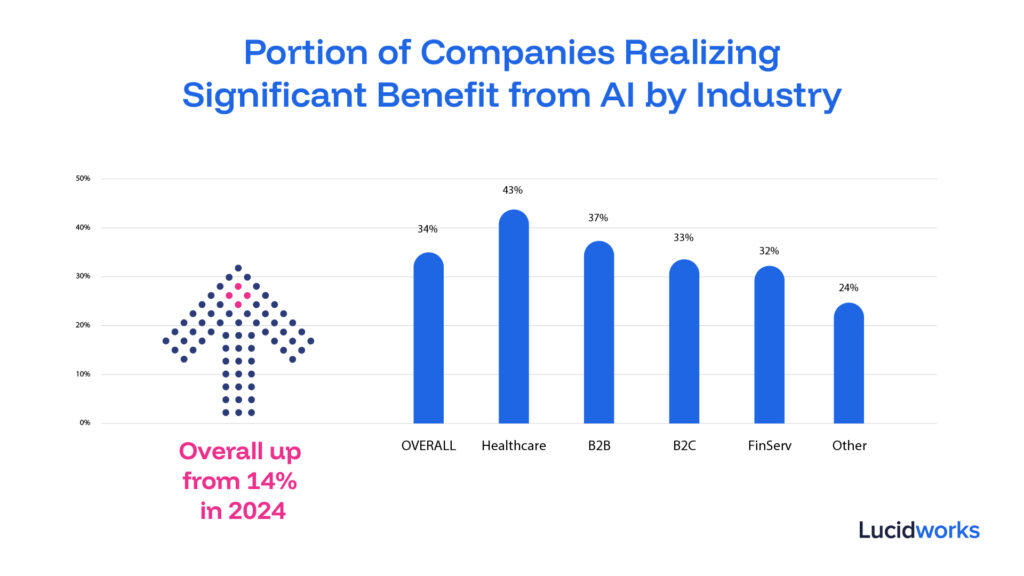
Got complex products? It’s time to rethink your PDP FAQ with AI
If your product page isn’t converting, your FAQ (or lack thereof) might be the problem. Learn how AI-powered answers can clear up confusion and help shoppers click “buy.”
At a glance:
- 34% of B2C retailers are already testing AI-powered guided selling tools
- Traditional FAQ sections are failing to address the specific, contextual questions that influence purchase decisions
- AI-powered Q&A systems can instantly provide personalized answers about compatibility, specifications, and usage scenarios at scale
Could conversion obstacles be stemming from inadequate product information delivery on retail product detail pages (PDPs)? As product catalogs only get bigger and customer expectations for immediate, precise answers intensify (due to the impact of AI agents on search and browse behavior), it begs the question: is it time to do a hard reset on traditional approaches to product education?
While many companies are cautiously approaching AI implementation, 34% of B2C retailers are already testing and deploying AI-powered guided selling tools. The key is starting with focused, high-ROI applications like intelligent product Q&A rather than trying to transform everything at once.
“I don’t need to see gimmicks and gizmos in AI. What I need to see is AI that actually helps me do my every day, day-to-day job within search.” — Ryan Finley, Senior Manager of E-commerce, Search and Findability at Ferguson
This shift has prompted a fundamental reconsideration of how retailers present complex product information to online shoppers, with companies reporting significant improvements in conversion rates after implementing AI-powered information systems on product pages.
The problem behind rising abandonment rates
Think about the experience of shoppers for a large, expensive purchase like an oven: they have a lot of questions about specs, functionality, and price that they need answers to before they can purchase. And if it’s not clear if that oven is the right fit for them, meaning they have major information gaps, they’ll head elsewhere.

“Every company claims they’ve ‘implemented AI,’ but there’s a massive gap between having an AI feature and having one that doesn’t frustrate your customers. We measure what matters – does it actually help people find what they need?” — Guy Sperry, CTO, Lucidworks
Industry observations suggest that customers often spend significant time on product pages before abandoning their purchase journey when specific information needs remain unaddressed. This pattern occurs across diverse product categories, from consumer electronics to home improvement supplies.
The phenomenon affects many product categories:
- In consumer electronics, customers might abandon purchases when they cannot determine device compatibility with existing accessories.
- In apparel, sizing charts could fail to address fit questions for specific body types or style preferences.
- In home improvement, technical specifications often lack practical context for real-world applications.
Common information gaps across product categories
Retailers across different sectors encounter similar challenges when presenting complex product information to customers:
- Technology Products: Compatibility questions represent a significant portion of pre-purchase inquiries. Customers examining a wireless mouse need to know whether it functions effectively on glass surfaces or whether battery life maintains performance during extended gaming sessions. Standard specifications rarely address these practical applications.
- Clothing and Accessories: Fit and care instructions generate substantial customer service volume. A customer considering a business jacket requires information about wrinkle resistance during travel or whether the fabric performs adequately in humid climates, details that traditional size charts cannot provide.
- Home and Garden: Installation and compatibility issues contribute to product returns. Customers purchasing a ceiling fan need to understand whether their existing electrical box supports the unit’s weight and vibration characteristics, information that basic specification sheets typically omit.
- Beauty and Personal Care: Ingredient interactions and skin type compatibility influence product satisfaction. Shoppers evaluating a new foundation need to know whether the formulation will separate when applied over their current skincare routine or whether the color oxidizes differently on various skin undertones.

“We don’t have to go in and validate that the results are good, our customers are telling us the results are good. We’ve had some dramatic growth.” — Marc Desormeau, Global Search Lead, Lenovo
What are traditional vs modern information retrieval systems?
Here’s what we’re used to: Static FAQ sections, downloadable instruction manuals, and generic product descriptions. While reliable, they are now starting to fail to address the specific, contextual questions that influence purchase decisions from today’s shoppers.
The challenge is significant: research shows that 65% of companies still lack the fundamental capabilities to support sophisticated customer information needs. Yet those who are investing strategically in AI are seeing results. Overall, 34% of companies are now realizing significant benefits from AI implementations, with B2C retailers leading the charge at 33% adoption of advanced AI tools.
Modern customers expect immediate, targeted answers to highly specific questions without leaving the product page. This expectation creates opportunities for retailers to deploy AI in focused, measurable ways that directly impact conversion rates.
Think about the volumes of pre-purchase inquiries that could be resolved through intelligent product page interactions. These interactions represent both operational costs and conversion opportunities that AI-powered Q&A systems can address effectively.
The strategic opportunity: Testing AI where it counts
Rather than trying to implement AI everywhere at once, forward-thinking retailers are focusing on high-impact, controlled use cases that deliver clear ROI.
“Many businesses are excited about generative AI but don’t know where to start. Often, the need for AI arises when seeking information, making search the natural interface for this transformative technology. Lucidworks AI simplifies the journey with its orchestration engine, enabling companies to deploy impactful use cases that personalize user experiences without the risks or high costs of traditional AI solutions.” — Keri Rich, VP of Product, Lucidworks
Product page Q&A represents an ideal starting point because it:
- Addresses a clear customer pain point with measurable business impact
- Provides a controlled environment to test and refine AI capabilities
- Offers easy ROI measurement through conversion rate and customer service cost reduction
- Builds customer confidence in AI interactions through helpful, accurate responses
“We’re finding that many e-commerce companies are stumbling and panicking because they’ve been trying to run before they can walk.” — Mike Sinoway, CEO, Lucidworks
The companies seeing success aren’t necessarily the ones with the most advanced AI… they’re the ones applying AI strategically to solve specific customer problems.
Then there’s the scale challenge for large retailers
A single category might contain hundreds of variations, each with subtle but significant differences that impact functionality and compatibility.
Large electronics retailers, for example, may stock dozens of different laptop charging cables, each designed for specific device models and power requirements. Customers need to identify the correct cable for their particular laptop model and usage requirements, but standard product listings often lack sufficient detail for confident selection.

This is where AI-powered Q&A systems excel: they can instantly access detailed product specifications, compatibility databases, and usage scenarios to provide personalized answers at scale, something impossible to achieve with static content alone.
AI-powered solutions in action
Forward-thinking retailers are implementing AI systems that transform how customers interact with product information. These solutions go beyond static FAQs to provide dynamic, contextual responses based on specific customer needs.
- Interactive Product Q&A: AI systems can understand natural language questions about products and provide specific, helpful answers drawing from product specifications, user manuals, compatibility databases, and real customer experiences.
- Guided Selling: Conversational AI tools help customers navigate complex product choices by asking clarifying questions and recommending products based on specific use cases and requirements.
- Technical Interrogation: For complex consumer goods, AI can enable natural language queries of technical documentation, providing instant access to detailed specifications and implementation guidance.
These applications represent what experts call “Level 1” agentic AI, i.e. analytical agents that gather information and provide insights without making changes to systems. They’re sophisticated enough to deliver real value while remaining manageable and measurable.
The business case for AI-powered product information
The investment in AI-powered product information systems is paying off for early adopters. Companies are increasingly confident in their AI investments: while overall AI spending plans have moderated from the initial surge (dropping from 93% planning increases in 2023 to 62% in 2025), they’re seeing more benefits from AI than ever before – with 33% of B2C retailers reporting benefits (up from 14% in 2024).

This shift toward more strategic, focused AI implementation is generating better results. Retailers implementing AI-powered product information report:
- Reduced customer service volume for pre-purchase questions
- Improved conversion rates through better-informed customers
- Decreased return rates due to more accurate customer expectations
- Enhanced customer satisfaction through immediate, helpful responses
The key is starting with focused applications that solve real customer problems rather than trying to implement AI everywhere at once.
4 AI implementation strategies that work
- Start with high-value, low-risk applications: Product Q&A systems provide immediate customer value while allowing retailers to test and refine their AI capabilities in a controlled environment.
- Focus on product categories with complex information needs: Electronics, automotive parts, home improvement, and B2B products benefit most from AI-powered information delivery.
- Integrate with existing systems: The most successful implementations connect AI systems to existing product databases, customer service knowledge bases, and technical documentation.
- Measure and iterate: Track metrics like conversion rates, customer service ticket reduction, and customer satisfaction to continuously improve AI performance.
What’s the competitive advantage of AI-powered FAQ?
As AI technology becomes more accessible and customer expectations continue to evolve, AI-powered product information delivery is becoming a competitive requirement rather than a nice-to-have feature.
The retailers who are succeeding aren’t necessarily the ones with the most advanced AI infrastructure, but they are the ones applying AI strategically to solve specific customer problems in measurable ways. Product page Q&A represents an ideal proving ground for these capabilities.
The evidence is clear: companies are continuing to invest in AI where it delivers clear value. 83% of AI leaders report major or extreme concern about AI costs and effectiveness, which means they need to be more strategic about where and how they implement it.
For retailers currently experiencing unexplained conversion rate challenges or high abandonment rates on product pages, AI-powered Q&A systems offer a focused, measurable path forward. The technology is proven, the use case is clear, and the ROI is trackable.